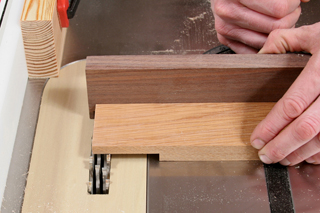
Why do companies make 8-in. dado blades? If a saw is made for a 10- or 12-in. blade, that is the optimum surface cutting speed for that saw and that is where it operates the safest. When you change to a dado set (whether it be a set or a wobbler type blade), you are compromising on your safety on that saw because you are now cutting much more material and you have to be more attentive. Now you change to an 8-in. blade and you are running at a reduced cutting speed (20 percent on a 10-in. and 33 percent on a 12-in. saw). I would think that this reduced cutting speed and the wider blade would seriously compromise your safety on the saw! Why don’t companies make 10- and 12-in. dado sets to maintain more safety on the saw? – Lee Volberding
Tim Inman: This is going to sound obvious, but smaller diameter blades have a shorter radius. An 8-inch blade will leave less to clean out by hand if you’re cutting a blind dado. A 12-inch dado would leave quite a bit to clean by hand, in comparison. More importantly, an 8-inch dado set would not require as much power as a 12-inch set, either. Other than these obvious differences, smaller sets can be a little cheaper to buy, too. Cutting speed, material removal rates, feed rate, etc. are all variables that the operator must understand and take into consideration when setting up and making cuts. This is part of becoming a skilled woodworker. The rpm of the saw’s arbor is not variable, but everything else is. There is not one “right” speed. The hardness of the wood, the dryness of the wood, the composition of the wood, the grain direction of the wood being cut (dado sets will cut dado joints across the grain, and plow joints with the grain) – all these factor into the operator’s decision as to how deep the cut might be in order to have a clean, perfect, safe job. Setting a dado head to take out all the waste wood in one pass, and then ramming the boards across the saw at fast feed speeds, hell or high water, will not only result in a poor job, but extra wear and tear on the saw – and possibly the operator. Make light cuts, make multiple passes, and learn the traits of your saw and the cutting heads you put in it. Make practice cuts on scrap before each new job. For hands-on woodworkers, there is as much art in the craft as engineering science. A big part of the “art” is to learn and understand our tools and how they work best for the task at hand and the materials in use. I often like to compare our craft to medicine. Even though there is a great deal of science that goes into medical training and the practice of medicine, the beautiful new clinic they built in my town has a nice big sign out front that reads: “Medical Arts Building.” Even the docs have to learn how to get the best out of their equipment and materials. That’s the art of it for both of us.
Cliff Paddock: Machine manufacturers actually determine the appropriate sized dado that can be used on their machine. They determine this given the design of the arbor, power transmission system and motor, along with safety considerations and other factors that influence the best size for their machine. Some 10” saws actually will only allow 6” dadoes. Dadoes remove a lot more of material than a blade does and are harder on the saw than a standard blade. You should only use the size the saw manufacturer recommends. (Cliff Paddock is Director of New Product Development at Freud Tools.)
Chris Marshall: I’m certainly a far cry from a table saw engineer, but given the considerable weight of a stacked dado set with potentially all of its chippers in place, I can see why a smaller overall diameter might prevent some unnecessary wear and tear on the arbor and trunnion assembly, as opposed to a 10-in.-diameter dado blade. Aside from this, a dado set is just plain a different animal from a standard blade. While the smaller diameter might not provide optimal cutting speed, neither does its extra weight or big bite. The whole cutting dynamic changes with a dado blade, one way or the other. I’ve never had a bad experience when using a dado set, but as Tim says, finesse and extra safety precautions need to serve their role. I feed workpieces slowly but steadily, I use hold-downs and featherboards whenever they are feasible and I take multiple passes for hogging out deep cuts. Dado blades serve me well, but I use them with reserve and respect.





